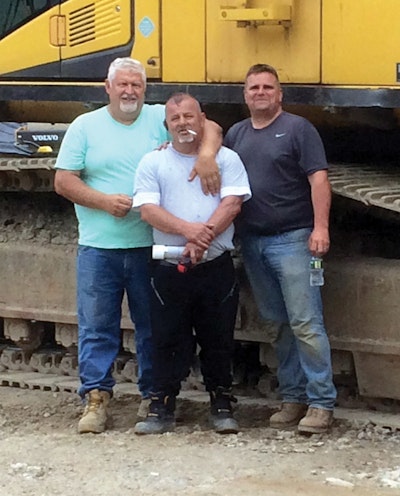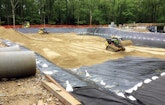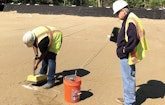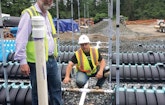
Workers from New England Liner Systems thermal-fusion weld seams where the 40-mil liners overlap in the revetment. (Photos courtesy of Green Construction Management)
A private school in Greenwich, Connecticut, wanted to expand its nursery through ninth grade facilities by building a high school for 550 students. E.E. Cruz won the general contractor bid, and Mark Lancor, P.E., principal engineer at DYMAR in Southbury designed the 10,000-gpd onsite system.
“The site has soils with low permeability, shallow depths to ledge and a seasonal high water table at 18 inches below grade, ruling out a conventional subsurface drainfield,” Lancor says. Some of his design included a grease interceptor, five septic tanks, a membrane bioreactor with ZeeWeed 500Ds cassette module (SUEZ Water Technologies & Solutions), four pump stations with Barnes pumps (Crane Pumps & Systems), and a 180-by-137-foot-wide constructed-fill drainfield covered by a parking lot. All concrete tanks were H-20 traffic rated.
Green Construction Management in Waterbury had the expertise to install such a drainfield and a long list of large commercial systems that verified the company’s reputation for trouble-free installations. On Lancor’s recommendation, Mark Green, the company owner, met with the general contractor.
“I didn’t leave with a signed contract, only the feeling that I’d get the job,” Green says. He stuck out his neck and acted on the hunch.
System operation
Permeate from the membranes is UV-disinfected, stored in a 5,400-gallon tank and used to flush the school’s urinals and toilets. Overflow from the tank flows to a pump station dosing the 19,728-square-foot drainfield of CULTEC chambers. A rock revetment underdrain at the west end collects permeate and conveys it to a wet well pumping to a 6,000-gallon fiberglass storage tank near the school’s main entrance. Duplex pumps distribute flow to an irrigation dripfield under a multipurpose athletic field. Quick4 high-capacity chambers (Infiltrator Water Technologies) protect the lines.
Handshake deal
Lancor required the constructed fill, a custom mix of septic gravel and sand, to meet a permeability rate of 37 to 60 feet per day. “The only way I would be able to sleep at night was if I knew the mix came from Laurelbrook Natural Resources,” Green says. He met with owner and friend Bob Jacquier to explain the predicament and deadline.
The high school was due to open in September 2019. When and if Green landed the job, he’d have to wait two months while Jacquier’s team mixed the required 8,000 tons and tested it for permeability, compaction and particle size (sieve). “Just testing each 500-cubic-yard pile took two weeks,” Green says. “We’d never have met the deadline had I waited for a contract.”
On a handshake, Jacquier began stockpiling the mix in early March. By the time Green signed the contract on Friday, May 3, the quarry had 4,000 tons ready for Green the following Monday. Meanwhile, E.E. Cruz had built the drainfield’s 5- to 7-foot-deep subgrade with 4% rise in elevation from west to east.
“All my subcontractor friends were busy and had to drop what they were doing when this job took off,” Green says. Monday morning, Dave Welch, owner of New England Liner Systems, and crew began installing the underlayment and the 40-mil high-density smooth HDPE liner (GSE Environmental) over it. The latter arrived on 870-by-22.5-foot-wide rolls, which were run out, overlapped, thermal-fused and tested for leaks at the welded seams.
Keep ’em rolling
Meanwhile, 15 to 22 dump trucks per day made the 4.5-hour round trip from the quarry in Canaan to deliver the custom mix. Wayne Green, Mark Green’s 72-year-old father, managed tickets and material inventories for all 355 loads.
By Wednesday, 2 tons of mix were on site and the liner had passed inspection. Green began stockpiling mix inside the pit at the center of the west face using a rented Volvo L110 wheel loader with 4-cubic-yard bucket. “Liners are slippery as ice, and the sandbags holding down the edges didn’t work as well as anchor trenches,” Green says. “No matter how carefully I dumped the mix over the side, the liner slid into the hole with it and had to be pulled back.”
Constructing the revetment required building a 10-foot-wide-by-12-inch-deep track-in road from the stockpile. Green drove one of two low-ground-pressure Volvo MCT125C rubber-tracked skid-steer loaders with 1-cubic-yard buckets. Tom Dauti, his friend and owner of Dauti Masonry, drove the second machine. They laid out and confirmed elevations using a Spectra Precision/Trimble LL500 laser level with Crain grade rod.
On Friday, Green and Dauti lined the revetment with filter fabric, brought in 2 feet of septic stone and laid the 6-inch perforated collection pipe, but there wasn’t time to cover it. Torrential rain fell over the weekend, causing Green to worry that the sand would wash down and contaminate the stone. “By Monday morning, I was so nervous I didn’t want to go to work for fear of what I would find,” he says. “Somehow, we were OK.”
Bucket by bucket
Even with two machines, building 12-inch-deep lifts over the entire liner went slowly, as each layer required six samples to be tested for particle size, moisture density, density of soil in situ and permeability before the inspection. In addition, heavy rains fell daily, turning buckets of mix to slush. The wet well pumps weren’t operational yet, so the crew dewatered the pit.
“It was a nightmare until the third lift was inspected, enabling us to bring in the rented Case 650M WT LGP crawler dozer with 8-foot-wide blade,” Green says. His retired uncle, Joey Paparazzo, used it to fine-grade the lifts. It took a month to build the 5- and 7-foot lifts, followed by a 3-inch base of 1 1/4-inch stone (Haynes Materials) for the 108 Contactor 100HD low-profile H-10 wheel-loading chambers (CULTEC).
From the manifold, Green and Dauti set nine galleys per row, only the end unit was 36 inches long instead of 96 inches long. Meanwhile, Wayne Green drilled and deburred 1/4-inch orifices every 4 feet in the distribution pipes. Lancor measured and inspected every hole.
Although the ball valves were all 1 1/2 inches, they required concentric reducers to telescope the manifold, enabling optimization of flow. “The first three rows closest to the west have 3-inch pipe, the next two rows have 2-inch pipe, and the last row has 1 1/2-inch pipe,” Mark Green says.
After Lancor conducted squirt tests to equalize the pressure in the pipes, Green and Dauti backfilled to the top of the galleys with 1 1/4-inch stone and covered them with filter fabric. Then they built thrust blocks with 8-inch manhole covers over the valves and clean-outs. Dauti Masonry poured the concrete.
Green handed the site to E.E. Cruz near the end of June.









